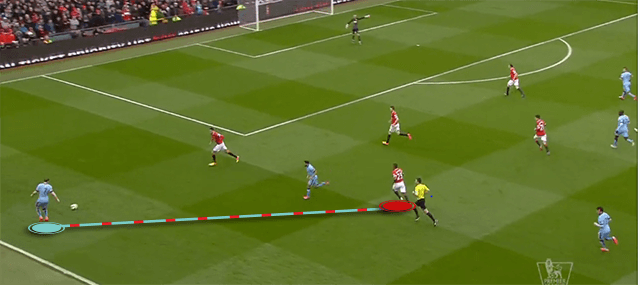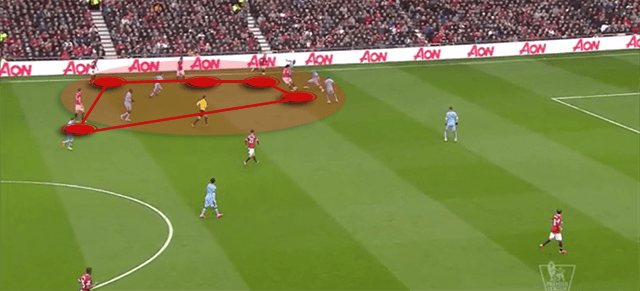Manchester gathered its two giants once again at Old Trafford; a journey for the Citizens that was found more strenuous owning more to the weight this match held rather than the time spent traveled. Louis Van Gaal’s men had re-created in recent weeks the Manchester United magic of yester years and had gained significant momentum that resulted in plenty of turned heads to take notice. To balance every rise with a fall, we barely had to look beyond the territorial limits of Manchester, as Manuel Pellegrini’s Manchester City found themselves in a downward spiral ever since the turn of the year. City’s loss last Monday night against Crystal Palace meant that United finally surpassed their cross town rivals in the league.
With millions tuned in to watch two expensively assembled teams (yes, two), the game provided the perfect platform for both these teams to make a statement: a win for United would mean their trend of bottling it against the bigger teams (from last season) would no longer be worthy of being called a trend and three points for City would, well, temporarily soften the self inflicted damage done in what has looked like an indolent title defence.
MANCHESTER UNITED 4-2 MANCHESTER CITY

Line-Ups
Manchester United: 1. De Gea; 25. Valencia, 12. Smalling, 4. Jones (Rojo 75′), 17. Blind; 16. Carrick; 8. Mata (Di Maria 81′), 21. Herrera, 31. Fellaini (Falcao 83′) , 18. Young; 10. Rooney
Manchester City: 1. Hart; 5. Zabaleta, 4. Kompany (Mangala 46′), 26. Demichilis, 22. Clichy; 15. Navas (Lampard 74′), 42. Toure, 25. Fernandinho, 21. Silva; 7. Milner (Nasri 63′); 16. Aguero
Goals: Young, Fellaini, Mata, Smalling // Aguero x 2
City focus on the wide channels for their attacks, leaving them susceptible in the middle when there’s a change of possession
City started with James Milner placed in a section between the four man midfield and Sergio Aguero up top. The primal intention of placing Milner here was so that he could latch on to Michael Carrick, who is renowned for his ability to dictate United’s play from a deeper role. While this move made sense theoretically, Pellegrini was quick, perhaps a bit too quick to let Milner stray out to the left periodically to go back to their usual strategy of accommodating David Silva right behind Aguero. While this produced magic for the visitors in the first ten minutes of the game, it’s daring to say that this minor change was where City could have both won and lost the game.
With Silva sitting pretty behind Aguero, this resulted in City having two extensively industrious outlets in the form of Jesus Navas on the right and James Milner on the left. Navas was up against Dutchman Daley Blind, who, despite being very calm on the ball and possessing quite a neat pass at hand, is far from being a suitable match for Navas’ pace while running up and down that flank. On the other side, Milner found himself facing Antonio Valencia, who, despite being capable of matching him step for step, can be outwitted considering the Ecuadorian isn’t the most intelligent (or natural) defender.
City chose to bypass the central region, focusing on the wider channels to exploit the respective advantages gained on either flank. The first quarter of an hour saw the the away side utilize this effectively, with multiple chances and the eventual goal from Aguero all courtesy of play on the flanks. With Gaël Clichy getting involved to get the advantage that Milner needed to get one up on Valencia, and Pablo Zabaleta making runs from deep to let Navas run into open space for the pass to be played, United’s defense looked vulnerable against Manchester City’s wing play.

Milner out wide with Valencia out of position
I mentioned earlier that Milner and Silva both drifted in and out of the left flank. This rolling method, perhaps in an attempt to cause a bit of chaos when with the ball did, to a certain extent backfire when without the ball; the times with Silva in the middle, Carrick was left to breathe freely, thus letting United’s passes flow. If City perhaps stuck to Milner clawing at Carrick’s heels, we may have had an altered result at the end of the 90 minutes.
But with the defensively unintelligent David Silva stuck in the middle, Manchester United’s passes out from the back and through the midfield in the event of recovery of possession resulting in a more direct and easy route towards the attacking third. This thus allowed the home side to display a more fluid sequence of passes into City’s box (and dare I say, possibly some of the most fluid play we’ve seen from Van Gaal’s side this season), with Michael Carrick as the fulcrum of this passing.
United overload City’s right flank as Van Gaal finds a defensive weakness in the away side
Pablo Zabaleta may have been City’s guardian on the right for some time now but it’s hard not to see that the Argentine isn’t having the best of seasons. To single him out in this instance would be cruel, having received minimal support from Jesus Navas or Yaya Toure on that side. United had Ashley Young on the flank in focus here, with Blind constantly providing support. The two have created a compatible partnership on that side. With Navas often staying a tad bit high up to be City’s outlet in attack, the Spaniard decided to forego a sound chuck of his defensive duties.
Yaya Toure, the midfielder on that side of the field, should be have been offering support to Zabaleta during times of man disadvantage but the Ivorian seemed to be lethargic at best in performing his duties. A key element in United’s attack was Marouane Fellaini’s movement to that left hand side, causing the overload that City found hard to deal with. The Belgian often drifted to that flank when United were in possession of the ball, often behaving as a target for the knock down from a long ball when build up play through the channel wasn’t possible.

United overload City’s right channel: 5 players within a small space
Manchester United’s approach to overload that flank made sense. Having Milner and Silva both focusing their attention on their left flank, United made sure that Valencia was cautious going forward. Of the midfield pair of Toure and Fernandinho, it is well known that the Brazilian’s role is more often than not, to mop up the mess and block the vacancies left by his midfield partner after streaming forward. Such duties would require Fernandinho to have a more reserved and withdrawn role, meaning City’s left central midfield would constantly have a man there. Van Gaal, like many of us, seemed to have noticed a cumulative effect of Toure’s lack of defensive discipline, Navas’ reluctance to be more defensive than offensive and Zabaleta’s off season fall on towards one side with that side proving to be more than fruitful with two of United’s goal originating from that space.
The Fellaini-Toure Showdown
The midfield tussle between Marouane Fellaini and Yaya Toure was anticipated and not so for a debate between who is the better player technically, but more so for who could be the bigger or rather better bully. We may not have gotten an answer to that question but we certainly found out which of the two was more disciplined on the night.

Fellaini overload on the left. De Gea’s long balls looked for the Belgian and his ability to win the header and find a team-mate
Fellaini’s instructions were evident as the game wore on. Defensively, the Belgian was expected to stay close to Toure and deprive him space to move the ball and work his way into the game. In essence, Fellaini was asked to stay within a few yards of the Ivorian to make sure that Toure wasn’t the best option for a City player to pass the ball to. Offensively, Fellaini’s role apart from being that big target object for David De Gea or either of the centre-backs was that he created that overload on City’s right flank as mentioned earlier. The once upon a time scapegoat at Old Trafford carried out his instructions to the letter and continued his excellent form.

Toure’s attempted marking of Fellaini was lethargic at best, with the Belgian facing minimal pressure
One of two things seemed evident with Toure’s instructions: either he wasn’t given any and was asked to play his natural game or he was asked to do this while simultaneously keeping a check on Fellaini. Toure managed to do neither well. There are significant number of instances you will notice if you re-watch the game where Toure is on the wrong side of Fellaini when United have the ball and it wasn’t being just a yard away but a good 5-8 yards off the man. Fellaini’s tendency to stray to City’s right flank led Toure to follow him in a rather lazy manner, leaving a hole in midfield. Courtesy a domino effect, Fernandinho shuffled in to guard a significant portion of the midfield single-handedly.

Gap in the midfield with both Toure and Fernandinho pushing out wide
Where does this leave them?
Since the FA Cup defeat against Arsenal, Van Gaal has made sure that suppressing Fellaini isn’t going to be good enough to beat Manchester United. The Dutchman has cultivated strengths in other areas of the pitch, with players such as Ander Herrera, Ashley Young, Juan Mata and Antonio Valencia all seeming to click simultaneously. Four points clear of City at the moment, United will look to capitalise on any slip ups that Arsenal go through. In quite typical fashion, United have built a strong and steady second half of the season, drawing echoes from the hallmark of the Sir Alex Ferguson years.Van Gaal will look to finish this season with less experimentation given that plenty of judgement will be passed come the end of this campaign.
As for City, one wouldn’t have expected such a poor second half of the season. It may be convenient to blame Manuel Pellegrini at this point but with many players clearly not giving it 100%, the City board have to decide and decide soon what big changes have to be brought about if they intend to be a team worth fearing. There have been interesting opinions on what has to be done at City and that all dwells in speculation for now but what is certain for now is that Manchester City have clearly flushed down their title defence and have to get their gut in the right place if they wish to save some face come the end of this season.
Written by Razim Refai
- Talent Radar Young Players Team of the Week #24: Niklas Sule, Kingsley Coman, and more - March 15, 2016
- Talent Radar Young Players Team of the Week #21: Alireza Jahanbaksh, Jurgen Locadia and more - February 16, 2016
- Talent Radar Young Goalkeeper Rankings: Jack Butland reclaims top position - February 16, 2016



























































